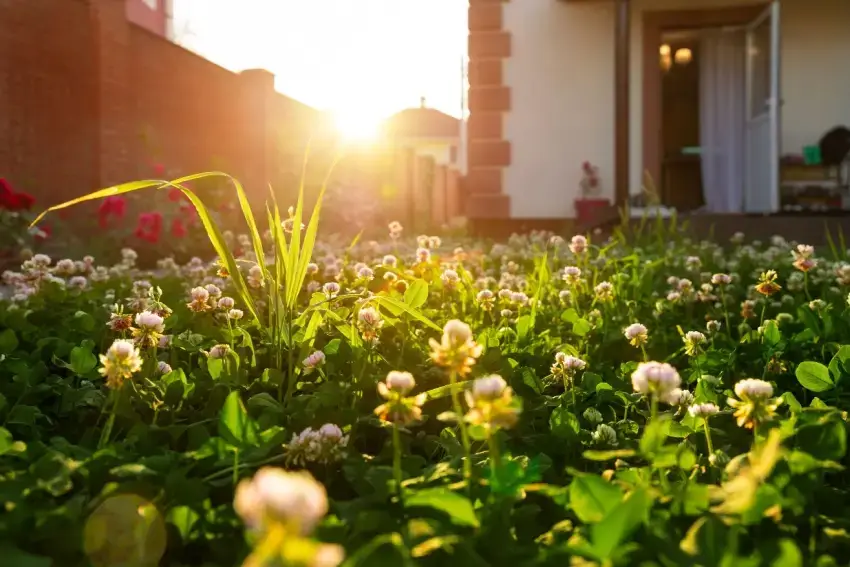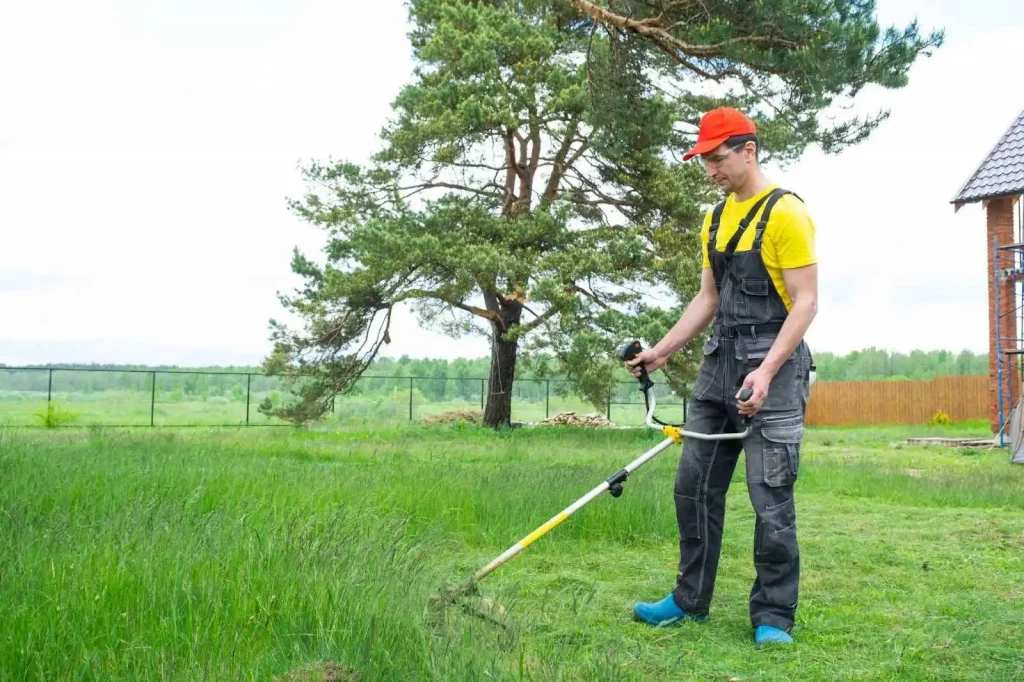Spring lawn weeds Ontario battles every year are emerging in full force as temperatures rise across Mississauga, Oakville, and Etobicoke. These tenacious invaders can quickly overtake your carefully maintained lawn if left unchecked. At Roseview Landscaping, we understand the frustration of dealing with persistent spring lawn weeds in Ontario, which is why we’ve created this comprehensive guide to help you identify and eliminate all 20 common culprits threatening your outdoor space this season.
The Critical Battle Against Spring Lawn Weeds in Ontario
Early intervention against spring lawn weeds in Ontario is essential for maintaining a healthy, lush lawn throughout the season. As our Ontario climate warms, winter annual weeds are already flowering while perennial spring lawn weeds in Ontario are emerging with vigor. Addressing these invaders now will significantly reduce your weeding workload throughout summer and fall.
When you tackle spring lawn weeds in Ontario early, you’re not just improving your lawn’s appearance—you’re preventing these weeds from establishing deep root systems and spreading thousands of seeds across your property. In Ontario’s unique climate, early intervention against spring lawn weeds means less work and better results.

20 Common Spring Lawn Weeds in Ontario: Identification and Control
1. Ground Ivy (Creeping Charlie)
This persistent perennial spring lawn weed in Ontario spreads aggressively through creeping stems that root at nodes. With its square stems, fuzzy leaves, and blue-purple flowers, ground ivy can quickly form dense mats across your Ontario lawn.
Control Tips: In lawns, iron-based herbicides can be effective but require multiple treatments. For garden beds, thorough hand weeding is recommended, ensuring all rooted nodes are removed.
2. White Clover
This creeping perennial creates dense patches that outcompete grass in Ontario lawns. Easily identified by its compound leaves with three tear-shaped leaflets and white globe-shaped flowers, white clover is a challenging spring lawn weed in Ontario but not impossible to manage.
Control Tips: Increasing nitrogen fertilization gives your lawn an advantage over clover. For severe infestations, bagging grass clippings helps prevent spreading.
3. Creeping Speedwell (Veronica filiformis)
This low-growing spring lawn weed in Ontario roots at leaf nodes, making it difficult to eliminate from lawns. Its kidney-shaped leaves and tiny blue flowers appear early in spring, often in pathways and lawn edges.
Control Tips: Maintain a thick, healthy lawn through regular fertilization and proper mowing height to prevent speedwell establishment. Hand pulling is effective for small infestations.
4. Dandelion (Taraxacum officinale)
Perhaps the most recognizable spring lawn weed in Ontario, dandelions have deeply notched leaves in a basal rosette and bright yellow flowers on hollow stalks. Their long taproots make them particularly stubborn.
Control Tips: Dig out the entire taproot using a dandelion tool when soil is moist. For lawns with numerous dandelions, pre-emergent treatments in fall can reduce spring lawn weed populations.
5. Purslane (Portulaca oleracea)
This annual spring lawn weed in Ontario grows horizontally in small round mats with succulent, shiny leaves. In Ontario lawns, purslane thrives in sunny areas and adapts to most soil types.
Control Tips: Pull plants before they set seed and remove from the site. Adding mulch to garden beds helps suppress germination of this common spring lawn weed in Ontario.
6. Stinkweed (Thlaspi arvense)
This annual or winter annual weed has a rank, garlic-like odor when crushed. It forms a small basal rosette before sending up stems with clusters of small white flowers, making it a distinctive spring lawn weed in Ontario.
Control Tips: Hand pulling is effective in gardens. Regular mowing prevents seed production in lawns affected by this spring lawn weed.
7. Yellow Rocket (Barbarée vulgaire)
This biennial or perennial spring lawn weed in Ontario forms a rosette of shiny, deeply divided leaves before sending up stems with golden yellow flowers. In Ontario, it blooms earlier than wild mustard.
Control Tips: Young plants are easy to pull up when soil is moist. For lawns, keeping turf healthy and vigorous helps prevent seed establishment.
8. Hairy Bittercress (Cardamine hirsuta)
An annual or biennial weed forming a rosette of pinnately compound leaves covered in short, fine hairs. Its small white flowers bloom in early spring, making it a common spring lawn weed in Ontario.
Control Tips: Hand weeding before seed set is critical, as seed pods explosively eject seeds when ripe. Frequent mowing in spring prevents flowering.

9. Chickweed (Stellaria media)
This annual or winter annual spring lawn weed in Ontario grows horizontally along the ground, rooting at nodes. With oval leaves and small white flowers, chickweed thrives in cool, moist conditions typical of Ontario springs.
Control Tips: Thorough hand pulling before flowering helps prevent spread. Maintaining thick turf through proper cultural practices helps prevent establishment of this spring lawn weed.
10. Mouse-eared Chickweed (Cerastium vulgare)
Distinguished from common chickweed by its hairy leaves and stems, this perennial forms low-growing mats that can quickly spread as a spring lawn weed in Ontario.
Control Tips: Regular mowing prevents flowering, while maintaining thick turf helps suppress growth. Iron-based herbicides may provide some control.
11. Wild Violet (Viola sororia)
With heart-shaped leaves and distinctive purple flowers, wild violets have dense fibrous root systems that make them a challenging spring lawn weed in Ontario. They thrive in moist, shady areas.
Control Tips: Dig out patches completely and reseed affected areas. Their waxy leaves make them resistant to many herbicides.
12. Rough Cinquefoil (Potentilla norvegica)
This annual, biennial, or short-lived perennial produces a rosette of compound leaves consisting of three elongated, toothed leaflets. Small yellow flowers bloom in June, making it a problematic spring lawn weed in Ontario.
Control Tips: Digging out the taproot is effective for control in both gardens and lawns. Preventing seed production is crucial.
13. Canada Thistle (Cirsium arvense)
This aggressive perennial spring lawn weed in Ontario can reach heights of up to 5 feet with spiny-lobed leaves and purple flowers. Its extensive underground rhizome system makes it particularly challenging to control in Ontario landscapes.
Control Tips: Cutting at ground level repeatedly helps deplete root reserves. Pulling or digging is not recommended as broken rhizomes will produce new plants.
14. Canada Fleabane (Conyza canadensis)
This native annual or winter annual can grow quite tall in Ontario lawns and gardens when given adequate water. Its deep green, hairy leaves form a basal rosette before sending up a flowering stem, identifying it as a common spring lawn weed in Ontario.
Control Tips: The shallow taproot makes it easy to pull in gardens and lawns. Preventing seed production is crucial, as one plant can produce 200,000 seeds.
15. Prickly Lettuce (Lactuca serriola)
This annual or biennial spring lawn weed in Ontario has a distinct milky sap that bleeds when cut. It forms a rosette of light green leaves with serrated edges before sending up a tall stem with yellow flowers.
Control Tips: Digging out the taproot is usually effective for controlling this spring lawn weed. Plants can produce thousands of windblown seeds, so prevention is key.
16. Shepherd’s Purse (Capsella bursa-pastoris)
This annual or winter annual forms a basal rosette similar to dandelion but with distinctive heart-shaped seed pods. In Ontario, seeds of this spring lawn weed typically germinate in fall but may also emerge in spring.
Control Tips: Hand digging is effective in gardens. Seeds require light to germinate, so maintaining dense plant coverage helps suppress growth.
17. Common Burdock (Arctium minus)
This biennial spring lawn weed in Ontario forms a large rosette of heart-shaped leaves in its first year before sending up a tall, branched stem in the second year. The purplish flowers form burrs that cling to clothing and animal fur.
Control Tips: Scout for young rosettes in spring and hand pull or dig them out. Removing flower stems before seed set is crucial.
18. Broad-leaved Plantain (Plantago major)
This perennial forms a low-growing rosette of oval leaves with prominent parallel veins. In Ontario lawns, its presence as a spring lawn weed often indicates compacted soil.
Control Tips: Dig out plants before they set seed. Alleviate soil compaction through core aeration and top dressing with compost to discourage this spring lawn weed in Ontario.
19. Galium Species (Bedstraw)
Two common varieties in Ontario are Clevers (Galium aparine) and Smooth Bedstraw (Galium mollugo). Both have leaves arranged in whorls around square stems and can spread rapidly as spring lawn weeds in Ontario.
Control Tips: Hand weeding is effective for Clevers (annual), while cutting at soil level repeatedly helps control Smooth Bedstraw (perennial).
20. Garlic Mustard (Alliaria petiolata)
This winter annual or biennial has a distinct garlic odor when crushed. It forms a rosette of kidney-shaped leaves in its first year before sending up flowering stems in spring, making it an invasive spring lawn weed in Ontario.
Control Tips: Hand pulling before flowering is effective. Dispose of plants in sealed bags, as they can continue to develop seeds even after removal.
Professional Lawn Maintenance: Your Best Defense Against Spring Lawn Weeds in Ontario
While DIY weed control can be effective for small areas, professional lawn care services offer comprehensive solutions for maintaining a weed-free lawn throughout the season. At Roseview Landscaping, our spring lawn maintenance programs include targeted strategies designed specifically for spring lawn weeds in Ontario.
Our professional team has the expertise to identify and treat these common spring lawn weeds in Ontario before they take over your property. We use environmentally responsible practices that comply with Ontario’s pesticide regulations while effectively managing weed populations.
Preventive Measures for Long-Term Control of Spring Lawn Weeds in Ontario
The best defense against spring lawn weeds in Ontario is a healthy, dense turf that can outcompete unwanted plants. Here are some preventive measures to incorporate into your seasonal lawn care routine:
- Proper mowing height: Keep grass at 2.5-3 inches to shade out spring lawn weed seedlings
- Regular fertilization: Strengthen your lawn with appropriate nutrients to combat spring lawn weeds in Ontario
- Core aeration: Reduce soil compaction and improve root development
- Overseeding: Fill in thin areas with desirable grass species to prevent spring lawn weeds from establishing
- Proper watering: Deep, infrequent watering encourages deep root growth and resilience against spring lawn weeds in Ontario
Trust Roseview Landscaping for Spring Lawn Weed Control in Ontario
Don’t let spring lawn weeds in Ontario overtake your beautiful property. Our family-owned and operated company has been serving high-income neighborhoods in Mississauga, Oakville, and Etobicoke for years, delivering exceptional results through expertise and attention to detail.
Contact us today at 416-672-0823 or sales@roseviewlandscaping.com to schedule a consultation and learn how our comprehensive lawn care programs can help you achieve a lush, spring lawn weed-free yard this season.
